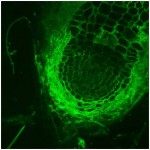 Root Growth Orchestration by Transcription Factors Expression
Root Growth Orchestration by Transcription Factors Expression
PI : Valérie Legué (UMR 1136 – IAM)
Co-applicants : M.B. Bogeat-Triboulot et I. Hummel (UMR 1137 – EEF)
Context — The root system plays a major role in plant development. Its own development, which involves root growth and the formation of lateral roots, is subject to numerous soil factors such as interactions with fungi, nutrient and water availability. The adaptability to environmental constraints of root development is a crucial property in tree functioning. Root system development, i.e. root growth and lateral root formation, is responsive to factors in the rhizosphere, including interactions with fungi, nutrient availability and water availability. While stem cells have been shown to play an important role in root development, the effects of environmental cues on their functioning has yet to be sufficiently assessed.
Objective — The goal of the ROOTex project is to test the hypothesis that root stem cells play a key role in the response of root growth to signals from the rhizosphere. Our analysis focuses on the implication of key transcription factors identified in Arabidopsis stem cells functioning.
Approach — We carried out a dual analysis of growth and gene expression, focusing on TF involved in stem cells activity in response to both mycorrhization and osmotic stress.
Key results —
- Root growth inhibition occurred as soon as after one week of contact with the ectomycorrhizal fungus. Stress growth was reduced according to stress intensity In response to osmotic.
- Poplar homologs of the candidate genes were identified from the poplar genome and specific primers were designed.
- We found that all studied TF were expressed in the poplar root apex, in control and both treatments.
- TF expression was monitored during the mycorrhization formation (1 point/week) showing a significant up-regulation of gene expression at the first week.
- Drought-induced regulation of gene expression are currently performed.
Main findings — Growth variations induced by the biotic and abiotic cues are related to those of TF expression in the whole root apex. Considering the cellular pattern of TF expression in Arabidopsis, it appears important to localise the FT expression within the more complex root meristem of poplar.
Future perspectives — While the post-doctoral position ends 1st April, we plan to analyse regulation of TF expression in Arabidopsis reporter lines (GUS, GFP, CFP) in response to water deficit.


